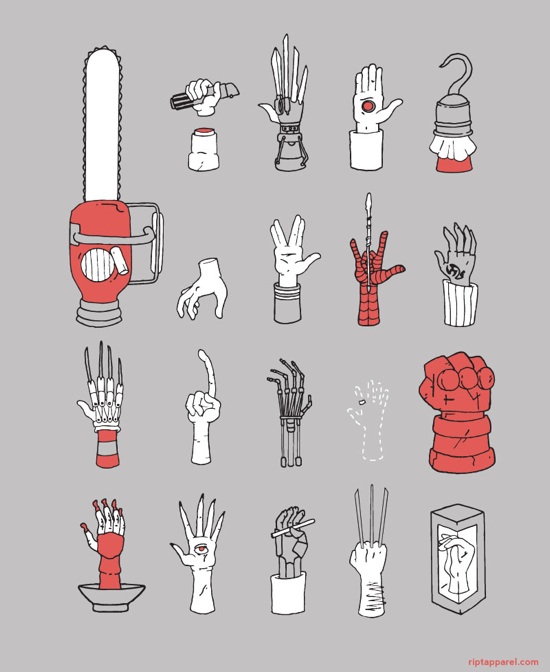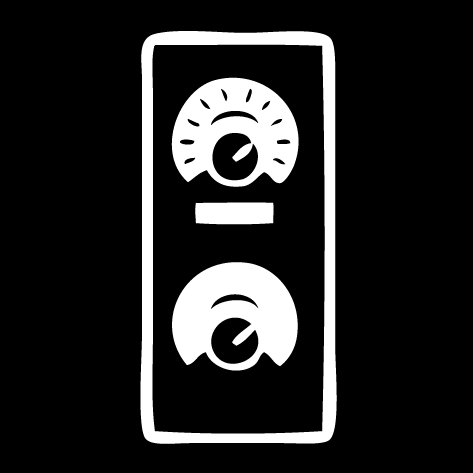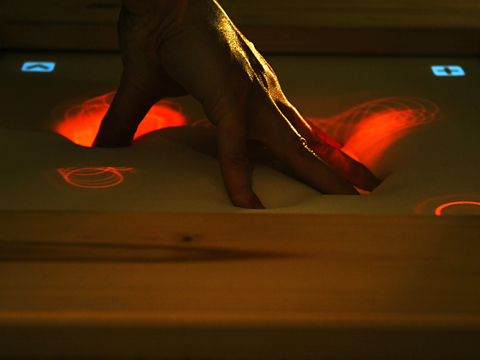physiology
“We’re suggesting that the ear evolved out of the skin in order to do more finely tuned frequency analysis.”
On 27, May 2011 | No Comments | In perception, physiology | By Dave
Recent research reveals some fun facts about aural-tactile synesthesia:
Both hearing and touch, the scientists pointed out, rely on nerves set atwitter by vibration. A cell phone set to vibrate can be sensed by the skin of the hand, and the phone’s ring tone generates sound waves — vibrations of air — that move the eardrum…
A vibration that has a higher or lower frequency than a sound… tends to skew pitch perception up or down. Sounds can also bias whether a vibration is perceived.
The ability of skin and ears to confuse each other also extends to volume… A car radio may sound louder to a driver than his passengers because of the shaking of the steering wheel. “As you make a vibration more intense, what people hear seems louder,” says Yau. Sound, on the other hand, doesn’t seem to change how intense vibrations feel.
Fingerprint ridge width is coupled to Pacinian resonance
On 05, Jan 2010 | No Comments | In perception, physiology, robotics | By Dave
French scientist Georges Debregeas has published a finding that the width of the ridges of our fingerprints just happens to be optimized for maximally vibrating our nerve endings:
The latest evidence suggests that fingerprints process vibrations in the skin to make them easier for nerves to pick up. They may seem little more than digital decoration, but biomechanics have long known that fingerprints have at least one use: they increase friction, thereby improving grip…
In fact the role that fingerprints play in touch is far more important and subtle than anyone imagined.
…Biologists have known for some time that Pacinian corpuscles are most sensitive to vibrations at 250Hz. So how do fingers generate this kind vibration? Biologists have always assumed that humans can control the frequency of vibrations in the skin by changing the speed at which a finger moves across a surface. But there’s little evidence that people actually do this and the Paris team’s discovery should make this view obsolete.
…They say that fingerprints resonate at certain frequencies and so tend to filter mechanical vibrations. It turns out that their resonant frequency is around 250 Hz. What an astonishing coincidence!
That means that fingerprints act like signal processors, conditioning the mechanical vibrations so that the Pacinian corpuscles can best interpret them…
The article also notes that in robotics this is called morphological computation; that is, computation through interactions of physical form.
Skin receptors may contribute to emotion
On 02, Jan 2010 | No Comments | In language, neuroscience, perception, physiology | By Dave
Interoception, the perception of internal feelings, is a funny thing. From our point of view as feeling beings, it seems entirely distinct from exteroceptive channels (sight, hearing, and so on). Interoception is also thought to be how we feel emotions, in addition to bodily functions. When you feel either hungry or lovesick, you are perceiving the state of your internal body, organs, and metabolism. A few years ago it was discovered that there are neural pathways for interoception distinct from ones used to perceive the outside world.
Interesting new research suggests that mechanical skin disturbances caused by pulsating blood vessels may significantly contribute to your perception of your own heartbeat. This is important because it means that skin may play a larger role in emotion than has been previously thought.
The researchers found that, in addition to a pathway involving the insular cortex of the brain — the target of most recent research on interoception — an additional pathway contributing to feeling your own heartbeat exists. The second pathway goes from fibers in the skin to most likely the somatosensory cortex, a part of the brain involved in mapping the outside of the body and the sense of posture.
This sounds surprising at first, but it makes perfect sense. There have been other instances where the functionality of perceptual systems overlap. For example, it’s been found that skin receptors contribute to kinesthesia: as the joints bend, sensations of skin stretch are used to perceive of joint angles. This was also somewhat surprising at the time, because it was thought that perception of one’s joint angles arose out of the receptors in the joints themselves, exclusively. The same phenomenon, of skin movement being incidentally involved in some other primary action, is at work here. We might be able to say that any time the skin is moved perceptibly, cutaneous signals are bound up with the percept itself.
In fact, I think this may be a good object lesson in how words about feelings can be very confusing. A few years ago, before the recent considerable progress in mapping the neural signature of interoception, the word ‘interoception’ was used to describe a class of perceptions—ones whose object was the perceiver. Interoception meant the perception of bodily processes: heartbeat, metabolic functioning, and so on. When scientists discovered a neural pathway that serves only this purpose, the word suddenly began to refer not to the perceptual modality, but exclusively to that neural pathway. Now that multiple pathways have been identified, the word will go back to its original meaning: a class of percepts, rather than a particular neural conduit.
The Hand
On 04, Jun 2009 | One Comment | In art, books, cognition, neuroscience, physiology, tactility | By David Birnbaum
 The Hand by Frank Wilson is a rare treat. It runs the gamut from anthropology (both the cultural and evolutionary varieties), to psychology, to biography. Wilson interviews an auto mechanic, a pupeteer, a surgeon, a physical therapist, a rock climber, a magician, and others—all with the goal of understanding the extent to which the human hand defines humanness.
The Hand by Frank Wilson is a rare treat. It runs the gamut from anthropology (both the cultural and evolutionary varieties), to psychology, to biography. Wilson interviews an auto mechanic, a pupeteer, a surgeon, a physical therapist, a rock climber, a magician, and others—all with the goal of understanding the extent to which the human hand defines humanness.
Wilson is a neurologist who works with musicians who have been afflicted with debilitating chronic hand pain. As he writes about his many interviews, a few themes emerge that are especially relevant to our interests here.
Incorporation
Incorporation is the phenomenon of internalizing external objects; it’s the feeling that we all get that a tool has become one with our body.
The idea of “becoming one” with a backhoe is no more exotic than the idea of a rider becoming one with a horse or a carpenter becoming one with a hammer, and this phenomenon itself may take its origin from countless monkeys who spent countless eons becoming one with tree branches. The mystical feel comes from the combination of a good mechanical marriage and something in the nervous system that can make an object external to the body feel as if it had sprouted from the hand, foot, or (rarely) some other place on the body where your skin makes contact with it…
The contexts in which this bonding occurs are so varied that there is no single word that adequately conveys either the process or the many variants of its final form. One term that might qualify is “incorporation”—bringing something into, or making it part of, the body. It is a commonplace experience, familiar to anyone who has ever played a musical instrument, eaten with a fork or chopsticks, ridden a bicycle, or driven a car. (p. 63)
Projection
Projection is the ability to use the hand as a bridge for projecting consciousness from one location to another. (Wilson did not use the word “projection” in the book.) In some ways, projection can be seen as the opposite of incorporation. Master puppeteer Anton Bachleitner:
It takes at least three years of work to say you are a puppeteer. The most difficult job technically is to be able to feel the foot contact the floor as it actually happens. The only way to make the puppet look as though it is actually walking is by feeling what is happening through your hands. The other thing which I think you cannot really train for, but only can discover with very long practice and experience, is a change in your own vision.The best puppeteer after some years will actually see what is happening on the stage as if he himself was located in the head of the puppet, looking out through the puppet’s eyes—he must learn to be in the puppet. This is true not only in the traditional actor’s sense, but in an unusual perceptual sense. The puppeteer stands two meters above the puppet and must be able to see what is on the stage and to move from the puppet’s perspective. Moving is a special problem because of this distance, because the puppet does not move at the same time your hand does. Also, there can be several puppets on the stage at the same time, and to appear realistic they must react to each other as they would in real life. So again the puppeteer must himself be mentally on the stage and able to react as a stage actor would react. This is something I cannot explain, but it is very imprortant for a puppeteer to be able to do this. (pp. 92–93)
Serge Percelly, professional juggler:
[An act is successful] not because you put something in the act that’s really difficult, but because you put something in the act in exactly the right way—in a way that makes it more interesting, not only for me but for the audience as well. I’m just trying somehow to do the act that I would have loved to see. (p. 111)
Skill
Wilson is a musician and a doctor to musicians, so he has special insight into the neurology of musical skill—which he recognizes as special case of manual skill that involves gesture, communication, and emotion.
Musical skill provides the clearest example and the cleanest proof of the existence of a whole class of self-defined, personally distinctive motor skills with an extended training and experience base, strong ties to the individual’s emotional and cognitive development, strong communicative intent, and very high performance standards. Musical skill, in other words, is more than simply praxis, ordinary manual dexterity, or expertness in pantomime. (p. 207)
The upper-limb (or “output”) requirements for an instrumentalist are not unique either; they depend upon the possession of arms, fingers, and thumbs, specific but idiosyncratic limits on the rage of motion at the shoulder, elbow, wrist, hand, and finger joints, variable abilities to achieve repetition rates and forces with specific digital configurations in sequence at multiple contact points on a sound-making device, and so on. Peculiarities in the physical configuration and movement capabisities of the musician’s limbs can be an advantage or disadvantage but are reflected in (and in adverse cases can be overcome through) instrument design: How wide can you make the neck of a guitar? How far apart should the keys be on a piano? Where should the keys be placed on a flute—in general? and for Susan and Peter? (p. 225)
Awareness
Touch experience can be a gateway to awareness, which can in turn heal both the mind and the body. Moshe Feldenkrais invented a form of physical therapy that focuses on stimulating an awareness of touch and movement sensations in order to relieve pain.
Most people slouch, tilt, shuffle, twist, stumble, and hobble along. Why should that be? Was there something wrong with their brains? After considering what dancers and musicians go through to improve control of their movements, [Feldenkrais] guessed that people must either be ignorant of the possibilities or refuse to act on them. So they just heave themselves around, lurching from parking place to office to parking place, utterly oblivious to what they are doing, to their appearance, and even to the sensations that arise from bodily movement. He suspected that people just lose contact with their own bodies. If and when they do notice, it is because they are so stiff that they can’t get out of bed or are in so much pain that they can barely get out of a chair. Then they start noticing…
What [Feldenkrais] was doing did not seem complicated. The goal of the guided movements was not to learn how to move, in the sense of learning to do a new dance step. The goal was not to stretch ligaments or muscles. It was not to increase strength. The goal, as he saw it, was to get the messages moving again and to encourage the brain to pay attention to them. (p. 244)
And his student, Anat Baniel, on the deep psychological roots of movement disorders:
I think working with children has given me this idea, which isn’t often discussed in medicine: a lot of disease—medical disease and emotional “dis-ease”—is an outcome of a lack of full development. It’s not something we can get to just by removing a psychological block…
Of course there are problems due to traumatic events in childhood, or disease—you name it. Feldenkrais said that ideal development would happen if the child was not opposed by a force too big for its strength. When you say to a small child, “Don’t touch that, it’s dangerous!” you create such a forceful inhibition that you actually distort the child’s movement, and growth, in a certain way.
Feldenkrais taught us to look for what isn’t there. Why doesn’t movement happen in the way that it should, given gravity, given the structure of the body, given the brain? For all of us there is a sort of sphere, or range, of movement that should be possible. Some people get only five or ten percent of that sphere, and you have to ask, “What explains the difference between those who get very little and those who get a lot?” Feldenkrais said that the difference is that in the process of development, the body encountered forces that were disproportionate to what the nervous system could absorb without becoming overinhibited—or overly excited, which is a manifestation of the same thing. (p. 252)
Feldenkrais’s approach is fascinating, but there is scant discussion in Wilson’s book about the role of the therapist’s hand in this process. After all, this kind of therapy is wholly reliant on an accidental discovery: that the patient can be made aware of her own body through an external, expert hand radiating pressure and heat. How is this possible? The topic isn’t explored.
There are many, many wonderful things to learn from this book for anyone with an interest in biology, art, music, history, or sports. You can find Frank Wilson on the web at Handoc.com
Cool animation of hand anatomy
On 06, Feb 2009 | No Comments | In art, physiology | By David Birnbaum

From Primal Pictures, makers of awesome anatomy models.
The Times on tactility
On 10, Dec 2008 | One Comment | In neuroscience, physiology, tactility | By David Birnbaum
The New York Times has published a piece on tactility and haptics. It’s pretty good, and it may inspire some readers to think more about the role touch plays in their lives. Many of the points made in the article are central to my research and my life, so a proper fisking in order. Let us begin.
Imagine you’re in a dark room, running your fingers over a smooth surface in search of a single dot the size of this period. How high do you think the dot must be for your finger pads to feel it? A hundredth of an inch above background? A thousandth?
I’m hooked. I have no idea, but I’m prepared to be surprised.
Well, take a tip from the economy and keep downsizing.
We dodge the silly reference to arrive at our answer:
Scientists have determined that the human finger is so sensitive it can detect a surface bump just one micron high. All our punctuation point need do, then, is poke above its glassy backdrop by 1/25,000th of an inch—the diameter of a bacterial cell—and our fastidious fingers can find it.
Wow! Seriously, that’s incredible. I wonder whether we can feel bacteria with our fingers in certain situations.
The human eye, by contrast, can’t resolve anything much smaller than 100 microns. No wonder we rely on touch rather than vision when confronted by a new roll of toilet paper and its Abominable Invisible Seam.
This is great—not the whimsical use of capital letters to catalog the phenomenology of toileting, but the comparison of tactile resolution to visual resolution. It’s a common misconception that touch is less precise than vision. After all, the visual processing we perform to communicate (i.e., reading and writing) can seem much more complex than touch. However vision isn’t necessarily more precise, it’s just more symbol-based, which makes it seem higher resolution because it is associated with complex concepts.
Biologically, chronologically, allegorically and delusionally, touch is the mother of all sensory systems. It is an ancient sense in evolution: even the simplest single-celled organisms can feel when something brushes up against them and will respond by nudging closer or pulling away.
I don’t understand “delusionally,” and really wonder what she means. However, it is interesting that simple animals can be said to feel by virtue of their ability to react to their environment, because it says a lot about the concept of feeling: that to feel is to be alive. Nicholas Humphrey wrote in Seeing Red, “The external world is the external world, and it is certainly useful to know what is going on out there. But let the animal never forget that the bottom line is its own bodily well-being, that I am nobody if I’m not me“.
It is the first sense aroused during a baby’s gestation and the last sense to fade at life’s culmination. Patients in a deep vegetative coma who seem otherwise lost to the world will show skin responsiveness when touched by a nurse.
The chronology of touch is crucial. As I’ve written before, touch frames experience. It sets the boundaries of your self, not only in space but also in time.
Like a mother, touch is always hovering somewhere in the perceptual background, often ignored, but indispensable to our sense of safety and sanity. “Touch is so central to what we are, to the feeling of being ourselves, that we almost cannot imagine ourselves without it,” said Chris Dijkerman, a neuropsychologist at the Helmholtz Institute of Utrecht University in the Netherlands. It’s not like vision, where you close your eyes and you don’t see anything. You can’t do that with touch. It’s always there.
Which, again, may say something about touch as a concept: that to live is to touch. Try to imagine that you would like to have the experience of “not touching anything.” You jump out of a plane, but realize that your body is being touched all over by air. You float in space (with no clothes on), and splay your limbs out so that you are sure to not even touch yourself. But sensory receptors throughout your body are still reflecting your body state—the angles of your joints, the stretch of your skin. Is it possible to conceive of a unfeeling animal?
Long neglected in favor of the sensory heavyweights of vision and hearing, the study of touch lately has been gaining new cachet among neuroscientists, who sometimes refer to it by the amiably jargony term of haptics, Greek for touch.
Haptics doesn’t mean touch. It relates to the perception and manipulation of one’s environment. And why is it amiable, because you said so?
They’re exploring the implications of recently reported tactile illusions, of people being made to feel as though they had three arms, for example, or were levitating out of their bodies, with the hope of gaining insight into how the mind works. Others are turning to haptics for more practical purposes, to build better touch screen devices and robot hands, a more well-rounded virtual life.
It’s interesting that the author assumes studying tactile illusions is impractical. In fact, we haptic interface designers use tactile illusions all the time to achieve design goals.
There’s a fair amount of research into new ways of offloading information onto our tactile sense, said Lynette Jones of the Massachusetts Institute of Technology. To have your cellphone buzzing as opposed to ringing turned out to have a lot of advantages in some situations, and the question is, where else can vibrotactile cues be applied?âFor all its antiquity and constancy, touch is not passive or primitive or stuck in its ways. It is our most active sense, our means of seizing the world and experiencing it, quite literally, first hand. Susan J. Lederman, a professor of psychology at Queen’s University in Canada, pointed out that while we can perceive something visually or acoustically from a distance and without really trying, if we want to learn about something tactilely, we must make a move. We must rub the fabric, pet the cat, squeeze the Charmin.
I doubt that Lederman actually said those words, because they’re inaccurate and Lederman is one of the leading scientists in the field. Tactile sensations do not require movement, haptic perception does. Touch is incredibly hard to talk about. To do so successfully we must be particular about terminology.
And with every touchy foray, Heisenberg’s Uncertainty Principle looms large. Contact is a two-way street, and that’s not true for vision or audition, Dr. Lederman said. If you have a soft object and you squeeze it, you change its shape. The physical world reacts back.
This is also important—the act of touching necessarily produces change in the world (and thus, the context of experience), making it, at least figuratively, a singularity, or an infinitesimal feedback loop. However, I’m quite sure the Heisenberg uncertainty principle is not involved. Maybe the author knows that. Did she mean to use a difficult concept in particle physics as a metaphor for another difficult concept in perceptual science? If so, does this make the point clearer or more complicated?
Another trait that distinguishes touch is its widespread distribution. Whereas the sensory receptors for sight, vision, smell and taste are clustered together in the head, conveniently close to the brain that interprets the fruits of their vigils, touch receptors are scattered throughout the skin and muscle tissue and must convey their signals by way of the spinal cord. There are also many distinct classes of touch-related receptors: mechanoreceptors that respond to pressure and vibrations, thermal receptors primed to sense warmth or cold, kinesthetic receptors that keep track of where our limbs are, and the dread nociceptors, or pain receptors—nerve bundles with bare endings that fire when surrounding tissue is damaged.
The signals from the various touch receptors converge on the brain and sketch out a so-called somatosensory homunculus, a highly plastic internal representation of the body. Like any map, the homunculus exaggerates some features and downplays others. Looming largest are cortical sketches of those body parts that are especially blessed with touch receptors, which means our hidden homunculus has a clownishly large face and mouth and a pair of Paul Bunyan hands.
There’s another part of the sensory homunculus that’s clownishly large. Go there!
“Our hands and fingers are the tactile equivalent of the fovea in vision,” said Dr. Dijkerman, referring to the part of the retina where cone cell density is greatest and visual acuity highest. “If you want to explore the tactile world, your hands are the tool to use.”Our hands are brilliant and can do many tasks automatically—button a shirt, fit a key in a lock, touch type for some of us, play piano for others. Dr. Lederman and her colleagues have shown that blindfolded subjects can easily recognize a wide range of common objects placed in their hands. But on some tactile tasks, touch is all thumbs. When people are given a raised line drawing of a common object, a bas-relief outline of, say, a screwdriver, they’re stumped. ‘If all we’ve got is contour information,’ Dr. Lederman said, ‘no weight, no texture, no thermal information, well, we’re very, very bad with that.’
This makes sense. If you think about it, the visual qualities of an object have little in common with sensory qualities of the same stimulus perceived through a different sensory channel. Imagine that you took a two dimensional contour of a screwdriver and mapped the X and Y values to pitch and loudness, and then listened to the contour of the screwdriver. It wouldn’t sound much like a screwdriver. In fact, I would bet that if you had someone listen to that, and then listen to silence, she would say that the silence sounded more like a screwdriver than the contour.
Touch also turns out to be easy to fool. Among the sensory tricks now being investigated is something called the Pinocchio illusion. Researchers have found that if they vibrate the tendon of the biceps, many people report feeling that their forearm is getting longer, their hand drifting ever further from their elbow. And if they are told to touch the forefinger of the vibrated arm to the tip of their nose, they feel as though their nose was lengthening, too.
I want to try this!
Some tactile illusions require the collusion of other senses. People who watch a rubber hand being stroked while the same treatment is applied to one of their own hands kept out of view quickly come to believe that the rubber prosthesis is the real thing, and will wince with pain at the sight of a hammer slamming into it. Other researchers have reported what they call the parchment-skin illusion. Subjects who rubbed their hands together while listening to high-frequency sounds described their palms as feeling exceptionally dry and papery, as though their hands must be responsible for the rasping noise they heard. Look up, little Pinocchio! Somebody’s pulling your strings.
It’s great to see that ordinary journalists are curious about tactility. The article includes many of my own talking points about touch, which is cool. Of course, the way to make someone really appreciate touch is by hugging or hitting them. Alas, writing about touch will have to do for now, until haptic technology makes its glorious arrival.
Targeted reinnervation
On 28, Sep 2008 | No Comments | In neuroscience, physiology, transhumanism | By David Birnbaum
A woman’s nerves have been rewired to help her control a prosthetic limb, an experimental procedure for amputees called targeted reinnervation. It’s a fascinating concept, and it works: a noncritical muscle’s nerves are deactivated, and the severed efferent (motor) nerve fibers from the missing limb are inserted into the muscle. The brain can then control a prosthesis by sending motor signals to the muscle. Additionally, the afferent (sensory) nerve fibers from the severed limb are moved to the skin above the same muscle. Stimulation of those nerves are now mapped as sensation originating from the prosthesis. Claudia Mitchell can control her prosthetic arm by sending motor signals to her chest muscle, and experiences cutaneous sensations in her prosthetic arm when the skin on her chest is touched or its temperature is changed.
Of course, rather than simply explaining the news in as clear a way as possible, ABC proceeds to extremes: “Mitchell has become the first real ‘Bionic Woman’: part human, part computer.” She’s first and she’s real, and you can tell because ABC even awarded her the official capitalized title of “Bionic Woman.” Presumptuous, and also inaccurate. In fact, this technology is exciting because it doesn’t have much to do with computers at all. Rather than relying on predictive software to control the motors in the prosthesis (which was the technique used in this BBC producer’s prosthetic foot), Ms. Mitchell controls her hardware directly, with her brain.
In any case, the success of this procedure has led to some interesting discoveries, such as the fact that Ms. Mitchell retains a 1-to-1 mapping of her reinnervated afferent fibers to locations on her prosthesis.
Paul Marasco, a touch specialist and research scientist with the Rehabilitation Institute of Chicago, was brought in to study the hand sensations that Mitchell feels in her chest. He put together a detailed map, connecting what Mitchell’s missing hand feels with the corresponding locations on her chest.
Depending on where you touch her chest, “she has the distinct sense of her joints being bent back in particular ways, and she has feelings of her skin being stretched,” Marasco said.
If a human’s nervous system can be extended to include a prosthesis, it isn’t a stretch to imagine that it can be interfaced with external signal networks, such as other humans’ nervous systems, or the internet. How will this affect embodied cognition? Societal structure? Consciousness?
Here’s a video of Claudia in action. Seems like she’s got style too—the upper part of her artificial arm is covered in a camoflauge pattern. Seen!
Mammalian skin may sense oxygen
On 28, May 2008 | No Comments | In perception, physiology | By David Birnbaum
Yet another sensory capability of skin has been discovered:
Biologists at the University of California, San Diego have discovered that the skin of mice can sense low levels of oxygen and regulate the production of erythropoietin, or EPO, the hormone that stimulates our bodies to produce red blood cells and allows us to adapt to high-altitude, low-oxygen environments.
“What we found in this study is really something quite unusual,” said Randall Johnson, a professor of biology at UC San Diego who headed the research study. “We discovered that mammalian skin, at least in mice, responds to how much oxygen is above it and, by virtue of that response, changes blood flow through the skin. This, in turn, changes one of the most basic responses to low oxygen that we have, which is the production of erythropoietin.”
Whiskers as haptic sensor arrays
On 26, Feb 2008 | No Comments | In cognition, neuroscience, physiology, robotics | By David Birnbaum
Whiskers provide animals with complex perceptual content. In fact, all the things that whiskers actually do are fascinating.
The dimensionality of the data can be modeled according to how an animal moves them through space:
Rat whiskers move actively in one dimension, rotating at their base in a plane roughly parallel to the ground. When the whiskers hit an object, they can be deflected backwards, upwards or downwards by contact with the object. The mechanical bending of the whisker activates many thousands of sensory receptors located in the follicle at the whisker base. The receptors, in turn, send neural signals to the brain, where a three-dimensional image is presumably generated.Hartmann and Solomon showed that their robotic whiskers could extract information about object shape by “whisking” (sweeping) the whiskers across a small sculpted head, which was chosen specifically for its complex shape. As the whiskers move across the object, strain gauges sense the bending of the whiskers and thus determine the location of different points on the head. A computer program then “connects the dots†to create a three-dimensional representation of the object.
More on that “three-dimensional image” from the end of the first paragraph — whiskers indeed construct a high resolution spatial map:
Based on discoveries in primates and cats, scientists previously thought that highly refined maps representing the complexities of the external world were the exclusive domain of the visual cortex in mammals. This new map is a miniature schematic, representing the direction a whisker is moved when it brushes against an object.“This study is a great counter example to the prevailing view that only the visual cortex has beautiful, overlapping, multiplexed maps,” said Christopher Moore, a principal investigator at the McGovern Institute and an assistant professor in the Department of Brain and Cognitive Sciences, where he holds the Mitsui Career Development Chair.
Researchers are now working towards developing code for a whisker-like sensor array to be used for robotics. Could this software have human interface applications as well?
This reminds me of the impressive and thought-provoking Haptic Radar/Extended Skin Project. Although the sensing medium in that case was ultrasound rather than a deformable, physical substrate, and the resolution of the stimulators much lower, the researchers state that they intend to make the system more whisker-like as they develop it.
[via Science Daily]
Compact tactile sensors
On 18, Feb 2008 | No Comments | In physiology, robotics | By David Birnbaum
Man, would I ever love to get ahold of one of these tactile sensors developed for the Shadow Robot Company. Responding to pressure ranging between 0.1 N and 25 N using a quantum tunneling composite material, each sensor has up to 34 individual sensing units, on-board digital signal conditioning, and is the size of a human fingertip. I would bet that this sensor could be used to crudely model the non-pacinian 3 (np3) psychophysical sensory channel, which constructs an acute neural image of skin deformation.
A development kit is available for £1450, which includes one sensor and some interfacing materials. That’s a bit out of my range, but if someone from Shadow is reading this, I will give you free publicity if you send me a sample!
(via aiGuru)







